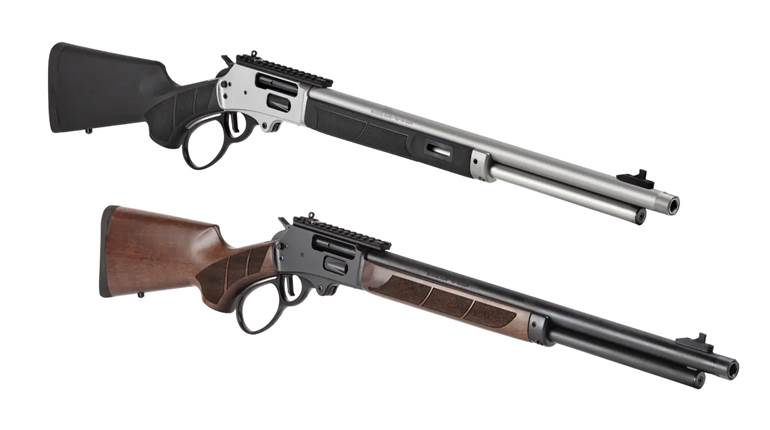
11/29/2012
The lever-action carbine has been a stalwart for personal protection for more than a century, with cowboys, cops and hunters all relying upon its handiness and reliability. With its synthetic six-position AR-style stock and tri-rail fore-end, Mossberg’s Model 464 SPX lever-action rifle, reviewed here, is obviously not the lever gun of John Wayne’s generation. Rather, it’s more like the lever gun of the new millennium.
The 464 action is based on that of the venerable John Browning-designed Winchester Model 94. Interestingly, the first model of the 464 was unveiled in early 2008— shortly after Winchester announced it would no longer be making standard Model 94s in the United States. The move was a savvy one on Mossberg’s part because it positioned the company to fill the gap left by Winchester for a lever-action carbine that still has a tremendous following.
As similar as the 464 and the 94 are, major differences do exist. For starters, the Mossberg has a solid rear receiver bridge that is drilled and tapped for scope bases. The bolt in the Mossberg is also round, more like that of a Marlin 336 as opposed to square as on the Winchester 94. The Mossberg also has a Marlin-style extractor, and it ejects to the side, so scope mounting is not an issue. Those familiar with the Winchester 94 will also notice that the throw of the lever on the Mossberg is a bit longer. But the action cycles very smoothly, and handloaders will appreciate the fact that the Mossberg will work with cartridges somewhat longer than can be cycled through a Winchester 94.
The other major difference between the Mossberg and the Winchester 94 or Marlin 336 is the safety. Both Marlin and Winchester opted for a receiver mounted cross-bolt safety that blocks the hammer. Thirty years ago, true lever-gun aficionados saw this minor enhancement as a disgrace to the lever-action legacy. Nevertheless, it provides an additional layer of safety. Mossberg’s approach leaves the receiver’s sides unmarred; the safety on all Model 464s is positioned on the receiver tang. The Mossberg safety also blocks the hammer, but at the rear as opposed to just aft of the firing pin, and the rebounding hammer does not have a half-cock position.
The company’s goal with the Model 464 SPX was to make a rifle that the average shooter could press into service during troubled times, as in the aftermath of natural disasters, and use for activities such as hog hunting. Given those situations, a tri-rail fore-end that would allow mounting a light, laser and other accessories made perfect sense. Other provisions included a threaded muzzle to let a hunter remove the flash hider and attach a suppressor to protect his and his hunting companions’ hearing.
Our sample Model 464 SPX reflected the typical Mossberg, made-in-America quality. Parts fit properly together and the matte blue finish was evenly applied. The gun’s open sights—a highly visible fiber-optic red front and green rear—were perfectly zeroed right out of the box. We fired the rifle for accuracy at 50 yards, and although the sights proved a bit coarse for precision work, sub-2-inch groups were not a problem from the bench nor was ringing a circular 8-inch steel plate at 100 yards from off-hand.
We ran more than 200 rounds through the Mossberg—75 from the bench and the rest from the off-hand position. Most of the off-hand shooting was by one tester’s 12-year-old son who commented that the 464 SPX was “one of the coolest rifles ever,” and said he appreciated the gun’s padded, six-position adjustable stock—especially after having his shoulder pounded by a “youth-size” lever-action .30-30 Win. rifle that did not come with a recoil pad. The youthful shooter did complain the 464 SPX’s tri-rail forearm was a bit sharp on his hands, but said no more about it after installing the three rubber ladder-style rail covers included with the gun.
The Mossberg Model 464 SPX is definitely a departure from the traditional lever-action legacy, and most shooters won’t feel all that cowboy-like when handling, shooting or hunting with it; however, having a rifle that can accommodate various physiques and is adaptable to a variety of tasks is more important than “playing cowboy” anyway.
Manufacturer: O.F. Mossberg & Sons, Inc.; (203) 230-5300; www.mossberg.com
Caliber: .30-30 Win.
Action Type: lever-action center-fire rifle
Frame: steel
Barrel: 16¼" chrome-moly with flash suppressor (optional)
Rifling: button; six-groove 1:10" RH twist
Magazine: six-round tube
Finish: matte blue
Sights: fiber-optic green rear and red front
Trigger: 5-lb., 12-oz. pull (as tested)
Overall Length: 33¾"- 37¾"
Weight: 6 lbs., 1 oz.
Stock: synthetic, six-position adjustable rear with pad, tri-rail forearm
Accessories: three rubber ladder rail covers, gun lock, owner’s manual
Suggested Retail Price: $535






































